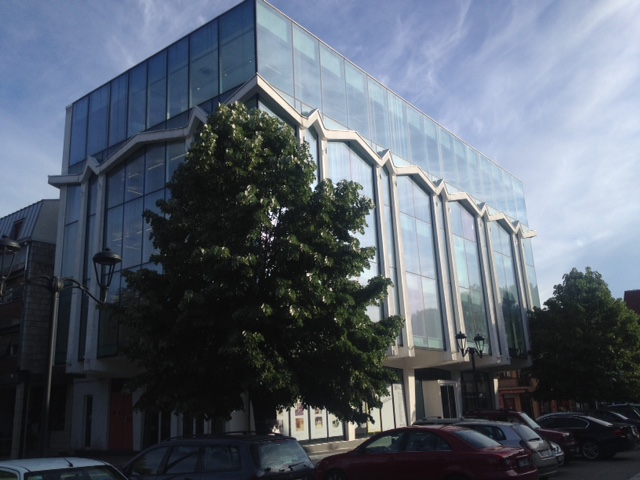 |
| Miodrag Dado Djuric art gallery |
At the Podgorica airport I plop next to Vjera Borozan in the car. It’s a hot afternoon and we’re both sweating. Vjera is the director of the National Museum of Montenegro. She is new at the job, she tells me - it’s been ten months and it’s tough because of immobilising politics. She’s also teaching at the Academy of Fine Arts in Prague where she also runs the online platform Artyčok TV. When I arrive back in Germany, I get the bad news she’s being replaced. Politics wins.
When we arrive in Cetinje the temperature has dropped. I was warned to bring a warm sweater: Montenegro has micro-climates. Cetinje is about 500 years old. But I’m a 1980s fan so I get excited when I see the Miodrag Dado Djuric art gallery in the city center. It’s a building from the Yugoslav socialist period. It has huge mirroring windows and for the opening of the gallery in 2012 the interior has been renovated in such a sparkling white you need to blink a few times before you can see the art.
On Friday morning it’s market in Cetinje. The local farmers come to the city to sell their cheeses, tomatoes, cherries and strawberries. I drink a “deutsch-Kaffee” in the bar opposite the gallery. It’s a typically Montengrin coffee that is made with two espressos and milk.
I'm not a fan of events like the Long Museum Night, but I enjoy the National Museum Day in Cetinje. It starts with a gathering of elderly people. Together they listen to gramophone records. In the afternoon there’s a fundraising for a shelter of homeless dogs. Later on, at the historical museum, people get together to recite and discuss anti-fascist poetry. The day ends with a concert. Priganice, small airy fritters with honey, are served together with the local wine Vrana, which means “black horse wine”, or more precise, as the artist Lazar Pejović explains: “horse, black as a crow.”
 |
| Montenegrin Black Horse Wine |
 |
| The historical museum in Cetinje |
 |
| Artists of Cetinje |
I hear about the ISU - an non-profit, ambulant institute of contemporary art founded in 2013. It has organized exhibitions like Drugarice (Comrades), an archive exhibition showing the women movement in Montenegro from 1943-1953. I only realize later on that I met its director, Natalija Vujošević, remembering her wearing a Yumco trench coat at the concert on Friday night.
I also hear rumors about a new Biennale being organized in Montenegro. The former one started in 1991, the year that also the war started. The new Biennale might take place in nature instead of the city. Maybe the arts will bring Montenegro to live up to its declaration as first Ecological State?